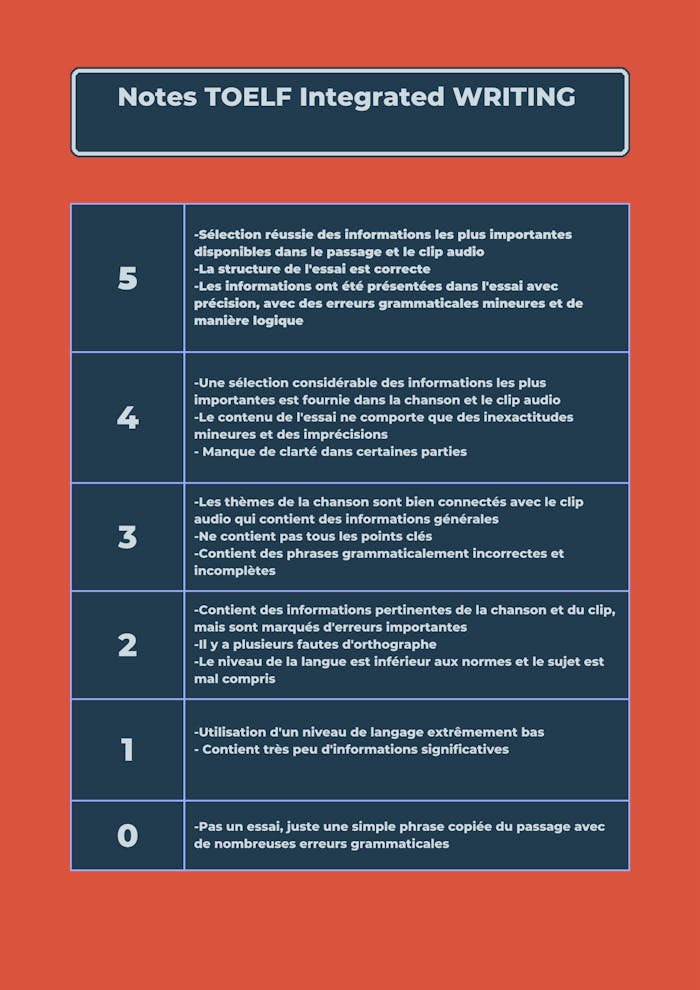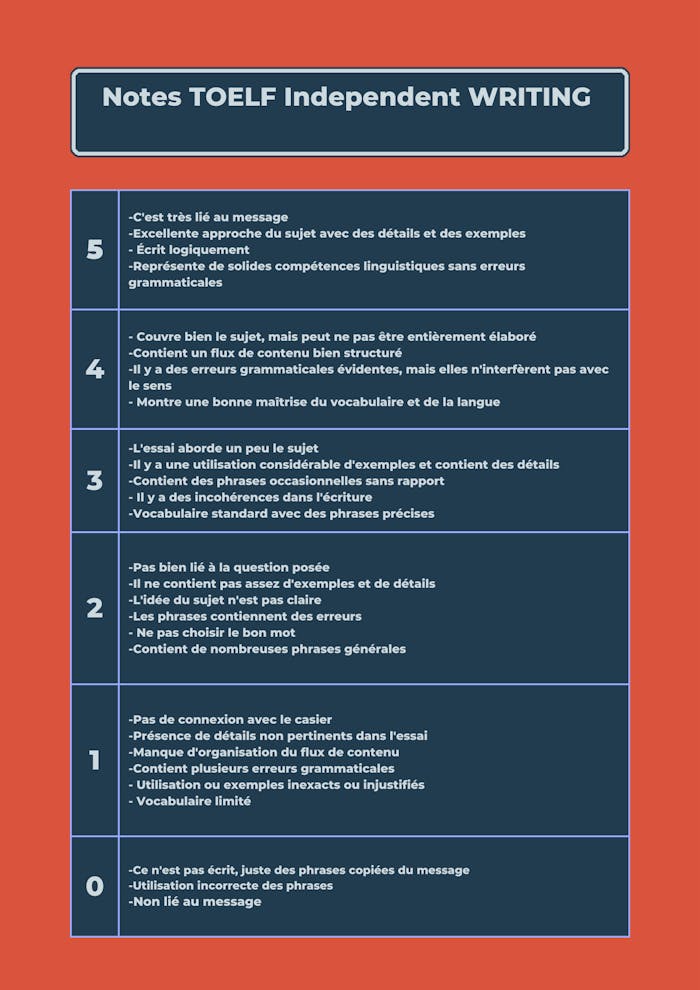TOEFL Writing: Qu'est-ce qu'un bon score?, difficulté, exemples pratiques et sujets.
L'écriture est l'une des pièces fondamentales de l'apprentissage de l'anglais, car elle nous permet d'organiser les compétences d'écoute et d'expression orale dans une structure qui nous prépare à l'utiliser au quotidien.
La section Writing du TOEFL iBT mesure votre capacité à écrire en anglais dans un environnement académique et votre capacité à présenter vos idées et concepts de manière claire et organisée.
Chez Speakingathome, nous pouvons vous aider à gérer cette partie de l'examen TOEFL
Rédaction TOEFL: Comment se déroule l'évaluation?
Le test TOEFL Writing est divisé en 2 parties : une partie Integrated Writing qui dure 20 minutes dans laquelle vous lisez un court passage et écoutez un court audio, puis écrivez et répondez à ce qui a été lu. Dans cette partie, vous êtes autorisé à prendre des notes sur ce que vous lisez.
L'autre partie de l'examen dure une demi-heure et consiste en la production d'un écrit indépendant (Independent Writing), qui doit être un essai basé sur une expérience personnelle ou une opinion en réponse à un sujet particulier. Ces 2 parties réunies ne dureront pas plus de 50 minutes.
TOEFL Writing: à quoi ressemble le système de notation ?
Le système de notation TOEFL Writing utilise un système de mesure de 1 à 30. 24-30 est avancé, 17-23 est intermédiaire supérieur, 13-16 est intermédiaire inférieur, 7-12 est basique et 0-6 est inférieur au basique. Cependant, cette partie de l'examen, étant divisée en 2 parties, est utilisée de 2 façons lorsqu'il s'agit de catégoriser les réponses.


Rédaction TOEFL: Difficulté
Comme mentionné ci-dessus, la difficulté dans la section écriture du test TOEFL dépendra de la façon dont le texte académique écrit est organisé. La cohérence, la variété du vocabulaire et la connexion des idées qui, ensemble, constituent un essai avec un bon fil conducteur et des réponses claires.
Cependant, ce n'est pas binaire, autant qu'en expression orale et écrite, il existe des degrés qui déterminent à quel point on peut être correct.
TOEFL Writing: Exemple
Writing Practice Set 1 (Integrated): Passage, Lecture, and Question Directions: Give yourself 3 minutes to read the passage.
Reading Time: 3 minutes
In an effort to encourage ecologically sustainable forestry practices, an international organization started issuing certifications to wood companies that meet high ecological standards by conserving resources and recycling materials. Companies that receive this certification can attract customers by advertising their products as “ecocertified.” Around the world, many wood companies have adopted new, ecologically friendly practices in order to receive ecocertification. However, it is unlikely that wood companies in the United States will do the same, for several reasons.
First, American consumers are exposed to so much advertising that they would not value or even pay attention to the ecocertification label. Because so many mediocre products are labeled “new” or “improved,” American consumers do not place much trust in advertising claims in general.
Second, ecocertified wood will be more expensive than uncertified wood because in order to earn ecocertification, a wood company must pay to have its business examined by a certification agency. This additional cost gets passed on to consumers. American consumers tend to be strongly motivated by price, and therefore they are likely to choose cheaper uncertified wood products. Accordingly, American wood companies will prefer to keep their prices low rather than obtain ecocertification.
Third, although some people claim that it always makes good business sense for American companies to keep up with the developments in the rest of the world, this argument is not convincing. Pursuing certification would make sense for American wood companies only if they marketed most of their products abroad. But that is not the case—American wood businesses sell most of their products in the United States, catering to a very large customer base that is satisfied with the merchandise
Directions: Read the transcript
Narrator: Now listen to part of a lecture on the topic you just read about.
Professor: Well, despite what many people say, there’s good reason to think that many American wood companies will eventually seek ecocertification for their wood products. First off, consumers in the United States don’t treat all advertising the same. They distinguish between advertising claims that companies make about their own products and claims made by independent certification agencies. Americans have a lot of confidence in independent consumer agencies. Thus, ecologically minded Americans are likely to react very favorably to wood products ecologically certified by an independent organization with an international reputation for trustworthiness.
Second point—of course it’s true that American consumers care a lot about price—who doesn’t? But studies of how consumers make decisions show that price alone determines consumers’ decisions only when the price of one competing product is much higher or lower than another. When the price difference between two products is small—say, less than five percent, as is the case with certified wood— Americans often do choose on factors other than price. And Americans are becoming increasingly convinced of the value of preserving and protecting the environment.
And third, U.S. wood companies should definitely pay attention to what’s going on in the wood business internationally, not because of foreign consumers, but because of foreign competition. As I just told you, there’s a good chance that many American consumers will be interested in ecocertified products. And guess what, if American companies are slow capturing those customers, you can be sure that foreign companies will soon start crowding into the American market, offering ecocertified wood that domestic companies don’t.
Directions: Give yourself 20 minutes to plan and write your response. Your response is judged on the quality of the writing and on how well it presents the points in the lecture and their relationship to the reading passage. Typically, an effective response will be 150 to 225 words. You may view the reading passage while you respond.
Response time: 20 minutes
Question: Summarize the points made in the lecture, being sure to explain how they cast doubt on specific points made in the reading passage.
Writing Practice Set 2 (Independent): Question
Directions: Read the question below. Give yourself 30 minutes to plan, write, and revise your essay. Typically, an effective response will contain a minimum of 300 words. Reading Time: 30 minutes
Question: Do you agree or disagree with the following statement? Television advertising directed toward young children (aged two to five) should not be allowed.
Use specific reasons and examples to support your answer
Rédaction du TOEFL: sujets et sujets fréquents
La plupart des sujets utilisés pour les examens TOEFL sont des affaires courantes liées à l'économie, à la société, à la politique, à la technologie et aux choses de tous les jours ; que le recyclage ou l'urbain.
De même, c'est pour cette raison de toujours être informé sur la culture générale afin de créer des réponses variées lorsque l'examen TOEFL doit être passé et de cette façon une écriture riche peut être faite.
